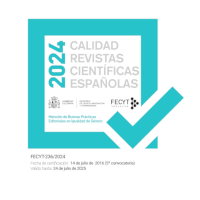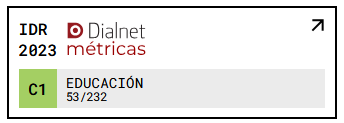El papel del maestro y la escuela en la Protección Infantil : Detección de casos y notificación en los servicios de protección infantil en La Rioja
DOI:
https://doi.org/10.18172/con.641Palabras clave:
Maltrato infantil, detección, notificación, servicios educativosResumen
En la actualidad una de las cuestiones que presenta mayor interés en el ámbito profesional de la Protección Infantil es la necesidad de establecer sistemas de trabajo que posibiliten la coordinación entre los diferentes recursos e instituciones y entre las diferentes disciplinas que trabajan alrededor de la familia y la infancia. El sistema educativo forma parte imprescindible del sistema de recursos que trabajan con los niños y niñas víctimas de malos tratos. Sin embargo, son muchas las dificultades y reticencias que presentan los profesionales de la educación (maestros, profesores, personal directivo) para detectar estas situaciones e implicarse en su resolución. El presente artículo tiene como objetivo sensibilizar a estos profesionales con el triple objetivo de justificar su papel en el abordaje del problema, vencer algunas de las mencionadas dificultades e informar sobre el procedimiento de notificación en la Comunidad Autónoma de La Rioja.Descargas
Citas
Ammerman, R. T. (1990). Etiological models of child maltreatment. A behavioral perspective. Behavior Modification, 14, 230-254.
Armenta, M. y Romero J. (2008). Consecuencias de la violencia familiar experimentada directa e indirectamente en niños: Depresión, ansiedad, conducta antisocial y ejecución académica. Revista Mexicana de Psicología, 2, 237-248.
Baginsky, M. y Hodgkinson, K. (1999). Child protection training in initial teacher training: A survey of provision in institutions of higher education. Educational Research Volume, 41, 173-181.
Banyard, V. L., Williams L. M. y Siegel, J.A. (2001). The long-term mental health consequences of child sexual abuse: An exploratory study of the impact of multiple traumas in a sample of women. Journal of Traumatic Stress, 14, 697-715.
Bernard, B. (1991). Fostering resiliency in kids: Protective factors in the family, school and community. Portland, OR: Western Regional Center for Drug-Free Schools and Comunities.
Brown G. R. y Anderson, B. (1991). Psychiatric morbidity in adult inpatients with childhood histories of sexual and physical abuse. American Journal of Psychiatry, 148, 55-61.
Cantón, J. y Cortés, M. R. (1997). Malos tratos y abuso sexual infantil. México: Siglo XXI.
Cantón, J. y Cantón-Cortés, D. (2007). Abuso sexual infantil. En E. Fernández de Haro, F. Justicia, M. C. Pichardo (Eds.), Enciclopedia de psicología evolutiva y de la educación (pp. 401-422). Madrid: Aljibe.
Cawson, P., Wattam, C., Brooker, S. y Kelly G. (2000). Child Maltreatment in the UK: A study of the prevalence of child abuse and neglect. London: National Society for Prevention of Cruelty to Children.
Cerezo, M. A. y Frías, D. (1994). Emotional and cognitive adjustment in abused children. Child Abuse & Neglect, 18, 923-932.
Cicchetti, D. y Toth, S. (2003). Child maltreatment: Past, present, and future perspectives. En R. Weissberg, H. Walberg, M. O’Brien y C. Kuster, (Eds.), Long-term trends in the well-being of children and youth: Issues in children's and families lives (pp. 181-205). Child Welfare League of America, Washington, DC.
Cicchetti, D. y Toth, S. (2005). Child maltreatment, Annual Review of Clinical Psychology 1, 409-438.
Consejería de Servicios Sociales, Gobierno de La Rioja (2003). Detección, notificación y registro de casos de Maltrato Infantil. Desde los Servicios Educativos.
Consejería de Servicios Sociales, Gobierno de La Rioja. Hoja de notificación de riesgo y maltrato infantil en el ámbito escolar.
Crittenden, P. (1992). Children´s strategies for coping with adverse home environments: An interpretation using attachment theory. Child Abuse & Neglect, 16, 329-343.
Crittenden, P. y Ainsworth, M. (1989). Child maltreatment and attachment theory. En D. Cicchetti y V. Carlson (Eds.), Child maltreatment: theory and research on the causes and consequences of child abuse and neglect (pp. 432-463). New York: Cambridge University Press.
De Paúl, J. y Arruabarrena, M. I. (1996). Manual de Protección Infantil. Barcelona: Masson.
De Paúl, J. y Pérez de Albéniz, A. (2007). Familias en las que hay malos tratos. En F. López (Coord.), La escuela infantil: observatorio privilegiado de las desigualdades, (pp. 137-154). Barcelona: Graó.
Fantuzzo, J. W. (1990). Behavioral treatment of the victims of child abuse and neglect. Child Abuse & Neglect, 14, 316-339.
Fergusson, D. M. y Horwood, L. J. (2003). Resilience to childhood adversity: Results of a 21-year study. En S. S. Luthar (Ed.), Resiliency and vulnerability: Adaptation in the context of childhood adversities (pp. 130-155). Cambridge: Cambridge University Press.
Hoffman-Plotkin, D. y Twentyman, C. T. (1984). A multimodal assessment of behavioral and cognitive deficits in abused and neglected preschoolers. Child Development, 55, 794-802.
Kaufman, M. (1962). Psychiatric implications of physical abuse of children. En V. De Francis (Ed.), Protecting the battered child (pp. 17.22). Denver, CO: American Human Association.
Kazdin, A. E., Moser, J., Colbus, D. y Bell, R. (1985). Depressive symptoms among physically abused and psychiatrically disturbed children. Journal of Abnormal Psychology, 94, 298-307.
Kelly, J. A. (1983). Treating child abusive families: Intervention based on skills-training principles. New York: Plenum.
Klimes-Dougan, B. y Kistner, J. (1990). Physically abused preschoolers´ responses to peers´ distress. Developmental Psychology, 26, 599-602.
Ley Orgánica 1/1996, de 15 de enero, de Protección Jurídica del Menor (BOE número 15, miércoles 17 de enero de 1996).
Ley Orgánica 2/2006, de 3 de mayo, de Educación (BOE número 106, jueves 4 de mayo de 2006).
Luthar, S. y Cicchetti, D. (2000). The construct of resilience: Implications for interventions and social policies. Development and Psychopatholgy, 12, 857-885.
Luthar, S. y Zigler, E. (1991). Vulnerability and competente: A review of research on resilience in childhood. American Journal of Orthopsychiatry, 61, 6-22.
Main, M. y George, C. (1985). Responses of abused and disadvantaged toddlers to distress in agemates: A study in the day-care setting. Developmental Psychology, 21, 407-412.
Martínez-Roig, A. y De Paúl, J. (1993). Maltrato y abandono a la infancia. Barcelona: Martínez Roca.
Melnick, B. y Hurley, J. R. (1969). Distinctive personality attributes of child abusing mothers. Journal of Consulting and Clinical Psychology, 33, 346-749.
Morales, J. M. y Costa, M. (1997). Tendencias actuales en la investigación del maltrato infantil. En J. Casado, J. A. Díaz y C. Martínez (Eds.), Niños maltratados (pp. 309-323). Madrid: Díaz de Santos.
Myers, J., Berliner, L., Briere, J., Hendrix, C., Jenny, C. y Reid, T. (2002). The APSAC handbook on child maltreatment (2nd ed.). Thousand Oaks, CA: Sage Publications, Inc.
Overstreet, S., Dempsey, M., Graham, D. y Moely, B. (1999). Availability of family support as a moderatos of exposure to community violence. Journal of Clinical Child Psychology, 28, 151-159.
Pereda, N., Guilera, G., Forns, M. y Gómez-Benito, J. (2009). The prevalence of child sexual abuse in community and student samples: A meta-analysis. Clinical Psychology Review, 29, 328-338.
Rak, C. y Paterson, L. (1996). Promoting resilience in at-risk children. Journal of Counseling & Development, 74, 368-373.
Rossato, C. (2009). Child protection training in sportrelated degrees and initial teacher training for physical education: An audit. Child Abuse Review, 18, 81-93.
Saldaña, D., Jiménez, J. y Oliva, A. (1995). El maltrato infantil en España: Un estudio a través de los expedientes de menores. Infancia y Aprendizaje, 71, 59-68.
Sanders, R., Colton, M. y Roberts, S. (1999). Child abuse fatalities and causes of extreme concern: Lessons from reviews. Child Abuse & Neglect, 23, 257-268.
Shonk, S.M. y Cicchetti, D. (2001). Maltreatment, competency deficits, and risk for academic and behavioral maladjustment, Developmental Psychology, 37, 3-17.
Spinetta, J. J. y Rigler, D. (1972). The child abusing parent: A psychological review. Psychological Bulletin, 77, 296-304.
Staller, K. y Faller, K. (2010). Child sexual abuse: Legal burdens and scientific methods. New York, NY, US: Columbia University Press.
Stone, S. (2007). Child maltreatment, out-of-home placement and academic vulnerability: A fifteen-year review of evidence and future directions. Children and Youth Services Review, 29, 139-161.
Straker, G. y Jacobson, R. S. (1981). Aggression, emotional maladjustment and empathy in the abused child. Development and Psychopathology, 17, 762-765.
Toth, S. L., Manly, J. y Cicchetti, D. (1992). Child maltreatment and vulnerability to depression, Development and Psychopathology, 4, 97-112.
U.S. Department of Health and Human Services, Administration on Children, Youth and Families. (2007). Child Maltreatment 2005. Washington, DC: U.S. Government Printing Office.
Wolfe, D. A. (1987). Child abuse: Implications for child development and psychopathology. London: Sage.
Zigler, E. y Hall, N. W. (1989). Child abuse in America: Past, present and future. En D. Cicchetti y V. Carlson (Eds.), Child maltreatment: Theory and research on the causes and consequences of child abuse and neglect (pp. 38-75). Cambridge: Cambridge University Press.
Descargas
Publicado
Cómo citar
Número
Sección
Licencia
El autor o autora conserva todos los derechos sobre su artículo y cede a la revista el derecho de la primera publicación, no siendo necesaria la autorización de la revista para su difusión una vez publicado. Una vez publicada la versión del editor el autor está obligado a hacer referencia a ella en las versiones archivadas en los repositorios personales o institucionales.
El artículo se publicará con una licencia Creative Commons de Atribución, que permite a terceros utilizar lo publicado siempre que se mencione la autoría del trabajo y la primera publicación en esta revista.
Se recomienda a los autores/as el archivo de la versión de editor en repositorios institucionales.













